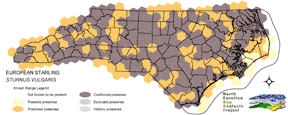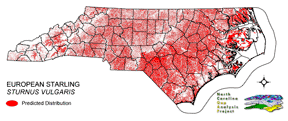
| Taxa: |
| Order: |
| Family: |
| Aves |
| Passeriformes |
| Sturnidae |
| NatureServe Global Rank: |
| NatureServe State (NC) Rank: |
| G5 |
| SE |
| Federal Status: |
| NC State Status: |
| --- |
| --- |


| Land Unit |
| US Fish & Wildlife Service |
| US Forest Service |
| US National Park Service |
| US Department of Defense |
| NC State Parks |
| NC University System |
| NC Wildlife Res. Com. |
| NC Forest Service |
| NC Div. of Coastal Mgmt. |
| Local Governments |
| Non-Governmental Org. |
| Other Public Lands |
| Private Lands |
| GAP Status 1-2 |
| All Protected Lands |
| Statewide |
| Hectares |
| 24,264.27 |
| 23,121.54 |
| 75,939.48 |
| 13,868.28 |
| 6,917.94 |
| 4,387.68 |
| 31,698.63 |
| 4,830.93 |
| 1,884.15 |
| 1,423.44 |
| 5,201.82 |
| 3,456.63 |
| 5,091,048.54 |
| 58,146.93 |
| 194,137.38 |
| 5,288,043.33 |
| Acres |
| 59,958.31 |
| 57,134.56 |
| 187,650.51 |
| 34,269.26 |
| 17,094.60 |
| 10,842.19 |
| 78,329.01 |
| 12,216.37 |
| 4,655.84 |
| 3,517.40 |
| 12,853.97 |
| 8,541.52 |
| 12,580,252.46 |
| 143,963.05 |
| 480,002.70 |
| 13,067,315.98 |
| % of Dist. on |
| Prot. Lands |
| 12.5 % |
| 11.9 % |
| 38.7 % |
| 7.1 % |
| 3.6 % |
| 2.3 % |
| 15.8 % |
| 2.5 % |
| 1.0 % |
| 2.6 % |
| 2.6 % |
| 1.4 % |
| < 0.1 % |
| 30.0 % |
| ----- |
| ----- |
| % of Dist. on |
| All Lands |
| 0.5 % |
| 0.4 % |
| 1.4 % |
| 0.3 % |
| 0.1 % |
| < 0.1 % |
| 0.6 % |
| < 0.1 % |
| < 0.1 % |
| < 0.1 % |
| < 0.1 % |
| < 0.1 % |
| 96.3 % |
| 1.1 % |
| ----- |
| ----- |
|
Common throughout the state (Potter et al. 1980). In almost every type of habitat except high elevations and dense forests (Potter et al. 1980), but perhaps prefers cities, towns, and agricultural areas (Fussell 1994). Requires a cavity for nesting, but is extremely adaptable in the type of cavity it will accept. Nests in natural tree cavities, woodpecker holes, holes in buildings, rock crevices, and bird houses (Nicholson 1997). NATURE SERVE GLOBAL HABITAT COMMENTS: Found in a wide variety of habitats including open wood- lands, agricultural and urban areas. Roosts in trees, shrubs, or buildings, forages in open areas (Godfrey 1966). May use cavity as night roost during nonbreeding season; this cavity may be used for nesting by same bird(s). REPRODUCTIVE HABITAT COMMENTS: Cavity nester. Nests in tree hole, woodpecker hole, axil of coconut palm, bird box, or crevice in building. Competes with flicker, Gila woodpecker, great crested flycatcher, bluebirds, and other cavity nesters for nest sites. See Weitzel (1988) for information on impact on native species in Nevada. |
| Code | Name | Description | NC Natural Heritage Program Equivalent |
| 3 | Tidal Marsh | Fresh and brackish tidal marshes, including cord grass, wild rice, sawgrass and needlerush alliances. | Brackish Marsh, Interdune pond, Maritime wet grassland |
| 124 | Maritime Scrubs and Tidal Shrublands | Coastal shrubs including wax-myrtle, swamp rose, alder, yaupon, and greenbriar. | Maritime Shrubs, Salt Shrub |
| 372 | Interdune Herbaceous Wetlands | Dune swales with permanently flooded to intermittently exposed hydrology. Species composition depends on salinity and can include cut grass, spike-rush, mosquito fern, and hornwort. | Interdune Pond, Maritime Wet Grasslands |
| 371 | Maritime Grasslands | Dune grass community consisting of sea oats and beach grasses. | Dune grass, Maritime dry grassland |
| 97 | Mesic Longleaf Pine | Longleaf pine woodlands without a major scrub oak component. Slash or loblolly pines may be present as well. | Mesic Pine Flatwoods |
| 42 | Xeric Longleaf Pine | Sandhills including a range of longleaf pine density from predominantly wiregrass, scrub oak dominated to true longleaf pine woodland. This does not include mesic or saturated flatwood types. | Xeric Sandhill Scrub, Pine/Scrub Oak Sandhill, Coastal Fringe Sandhill |
| 226 | Piedmont Xeric Woodlands | Generally post and blackjack oak dominated woodlands. White ash and pignut hickory can be found in combination with Eastern red cedar on glades. | Xeric Hardpan Forest |
| 20 | Coniferous Regeneration | Regenerating pine stands. Predominantly loblolly pine, but slash and longleaf stands occur as well. | No equivalent |
| 36 | Successional Deciduous Forests | Regenerating deciduous trees with a shrub stature. Commonly dominated by sweetgum, tulip poplars and maples. | No equivalent |
| 180 | Agricultural Crop Fields | Farm fields used for row crops. | No equivalent |
| 205 | Agricultural Pasture/Hay and Natural Herbaceous | Farm fields used for pasture grass or hay production, as well as old fields dominated by native and exotic grasses. | No equivalent |
| 213 | Barren; quarries, strip mines, and gravel pits | Quarries, strip mines, or gravel pits. | No equivalent |
| 214 | Barren; bare rock and sand | Areas of bare rock, sand or clay. | No equivalent |
| 60 | Sand | Exposed sand, predominantly in the sandhills region where disturbance or the extreme site conditions prevent natural regeneration. | No equivalent |
| 202 | Residential Urban | Includes vegetation interspersed in residential areas. Includes lawns, mixed species woodlots, and horticultural shrubs. Vegetation accounts for between 20 - 70% of the cover. | No equivalent |
| 203 | Urban Low-Intensity Developed | Highly developed areas with vegetation accounting for < 20% of the cover. | No equivalent |
|
Caccamise, D. F., L. A. Lyon, and J. Fischl. 1983. Seasonal patterns in roosting flocks of starlings and commongrackles. Condor 85:474-481.
Ingold, D. J. 1994. Influence of nest-site competition between European starlings and woodpeckers. Wilson Bull. 106:227-241. Fussell, J.O. III. 1994. A birderís guide to coastal North Carolina. Chapel Hill and London: The University of North Carolina Press. Weitzel, N. H. 1988. Nest-site competition between the European starling and native breeding birds in northwestern Nevada. Condor 90:515-517. Nicholson CP. 1997. Atlas of the breeding birds of Tennessee. Knoxville: University of Tennessee Press. Ingold, D. J. 1989. Nesting phenology and competition for nest sites among red-headed and red-bellied woodpeckers and European starlings. Auk 106:209-217. Bureau of Land Management. Life History Summaries. Godfrey, W.E. 1966. The birds of Canada. National Museums of Canada. Ottawa. 428 pp. Kerpez, T. A., and N. S. Smith. 1990. Competition between European starlings and native woodpeckers for nest cavities in saguaros. Auk 107:367-375. Harrison, C. 1978. A field guide to the nests, eggs and nestlings of North American birds. Collins, Cleveland, Ohio. Potter, E. F., J. F. Parnell, and R. P. Teulings. 1980. Birds of the Carolinas. Univ. North Carolina Press, Chapel Hill. 408 pp. Terres, J.K. 1980. The Audubon Society encyclopedia of North American birds. Alfred A. Knopf, New York. American Ornithologists' Union (AOU), Committee on Classification and Nomenclature. 1983. Check-list of North American Birds. Sixth Edition. American Ornithologists' Union, Allen Press, Inc., Lawrence, Kansas. Raffaele, H.A. 1983. A guide to the birds of Puerto Rico and the Virgin Islands. Fondo Educativo Interamericano, San Juan, Puerto Rico. 255 pp. Feare, C. 1984. The starling. Oxford Univ. Press. 190 pp. Pratt, H.D., P.L. Bruner, and D.G. Berrett. 1987. A field guide to the birds of Hawaii and the tropical Pacific. Princeton University Press, Princeton, New Jersey. 409 pp. + 45 plates. Raffaele, H.A. 1989. A guide to the birds of Puerto Rico and the Virgin Islands. Revised edition. Princeton Univ. Press. 220 pp. Glahn, J.F., et al. 1991. Impact of roost control on local urban and agricultural blackbird problems. Wildlife Society Bulletin 19:511-522. |
For more information please contact them at:
NC-GAP Analysis Project
Dept. of Zoology, NCSU
Campus Box 7617
Raleigh, NC 27695-7617
(919) 513-2853
www.basic.ncsu.edu/ncgap